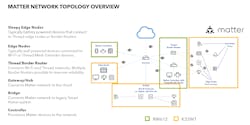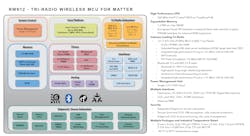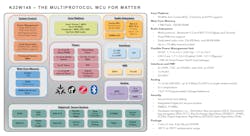This article is part of TechXchange: Why Matter Matters and Electronic Design’s coverage of CES 2023.
By expanding its suite of secure wireless microcontrollers (MCUs), NXP said it will become easier for customers to create smart-home devices that support the new Matter connectivity protocol.
According to the company, the new RW612 is the world’s first Matter-ready MCU with a three-in-one radio that supports Wi-Fi 6, Bluetooth Low Energy (BLE) 5.3, and the 802.15.4 protocol underlying Thread and Zigbee on a single chip. NXP maintains the RW612 gives customers the flexibility to support Matter over Wi-Fi, Thread, and Bluetooth, as well as other legacy protocols, plus the ability to bridge their products to all major smart-home ecosystems.
The K32W148, also designed by NXP, is a multiprotocol wireless MCU that unites Thread, Bluetooth, and Zigbee in a Matter-ready chip that’s ideal for a wide range of power- and space-constrained devices in the smart home.
“The next generation of consumer and industrial devices needs the right combination of an advanced MCU and secure connectivity across the most important protocols, including Thread, Wi-Fi, Bluetooth, and Matter,” said Larry Olivas, VP and GM of Wireless Connectivity Solutions at NXP.
Like many major IoT chip companies, NXP is betting on Matter to become the standard way for the smart home to communicate, uniting a market that has long been fragmented by the lack of compatibility between devices belonging to rival ecosystems.
It was these compatibility problems that pushed Apple, Google, Samsung, and a wide swathe of technology companies (including NXP) to create the open connectivity standard through the Connectivity Standards Alliance (CSA).
Matter serves a unifying application layer that allows IoT devices from different ecosystems to connect with each other even if they’re made by different companies. The standard, which started out as part of Project Connected Home over IP (Project CHIP) in 2019, works with a wide range of wireless technologies including Wi-Fi, Bluetooth, and Thread. That enables everything from smart thermostats to door locks, switches, and lights to connect locally without the use of a cloud—regardless of the company’s ecosystem.
NXP is expanding its portfolio of end-to-end Matter solutions at a time when many other semiconductor firms, including Silicon Labs and Texas Instruments, are starting to take the smart-home market more seriously (Fig. 1).
Ahead of the final Matter 1.0 standard being released late last year, Silicon Labs in September rolled out its first family of secure Wi-Fi 6 and BLE 5.1 chips ready to support the new IoT connectivity standard, with mass production expected to begin in mid-2023.
IoT Under Control
As the latest member of the Tri-Radio family it introduced at last year’s Consumer Electronics Show (CES), NXP said the RW612 uses the same high-performance Cortex-M33 as its i.MX RT family of “crossover” MCUs
The new RW612 is suited for a wide range of smart door locks, light switches, robots, and other devices that communicate via Wi-Fi or Thread to control the smart home, such as smart thermostats that allow users to set energy-efficient home heating and cooling cycles or even remotely adjust the temperature at any time via a smartphone. The Matter-ready MCU will be on display at CES 2023 this month, alongside NXP’s expanding portfolio of Matter solutions.
More specifically, NXP said RW612 can slot into smart-home devices that also serve as Matter “controllers” to provision devices to a network and, as a result, are one of the core building blocks of Matter’s network topology. These controllers—anything from a voice-controlled smart speaker to a smartphone would qualify—can universally communicate with any other device—as long as everything trying to connect meets the Matter standard (Fig. 2).
The RW612, according to NXP, also is ideal for Matter “border routers” that act as switchboards for smart-home devices communicating with each other over Thread and/or Wi-Fi. Furthermore, these routers can connect to a central gateway that’s linked to the cloud.
The wireless MCU works in several different configurations. It can act as the central processor in a smart-home device, giving you a smaller form factor and reducing bill-of-materials (BOM) costs. The alternative—suited for situations where power-savings are most important—is to integrate it with a separate processor and give it responsibility over smart-home protocols. As a result, the RW612 can run the radio independently while the central processor in the device remains in standby for power-saving purposes.
At the heart of the company’s latest Matter MCU is a Cortex-M33 CPU with TrustZone technology. It clocks at up to 260 MHz and is supplemented with 1.2 MB of on-chip RAM and interfaces for memory expansion.
According to NXP, the RW612 includes all of the other necessary building blocks for a Matter-ready wireless MCU, bringing a high degree of integration to reduce the complexity, cost, and footprint of smart-home devices (Fig. 3).
Its fast, configurable peripherals include a display controller and support for a wide range of serial protocols via FlexComm modules. The MCU integrates on-chip power management, which allows it to run from a single 3.3-V power supply.
The secure wireless MCU, which is currently sampling to early customers, is packed in 8- × 8-mm TFBGA, 9- × 9-mm HVQFN, or 5.165- × 4.680-mm WLCSP packages rated to tolerate temperatures from −40 to 85°C.
NXP also introduced the RW610, which belongs to the same family. It’s ready to support other features that include BLE audio and Auracast broadcast audio for portable audio devices or smart speakers.
Bridging the Gap
The multiprotocol K32W148 wireless MCU is designed to bridge the gaps between the many smart plugs, switches, sensors, and other—sometimes battery-powered—consumer devices in a smart home, said NXP.
The “tri-core” architecture isolates the radio and security execution environments to save the Cortex-M33 CPU at the heart of the wireless MCU, which contains 1 MB of flash and 128 kB of RAM, for the customer’s applications.
While it lacks Wi-Fi, the Matter-ready radio subsystem supports BLE 5.3 and existing smart-home protocols, including Thread and Zigbee, all of which share the same integrated antenna. According to NXP, the radio, supplemented by 256 kB of flash, also features what it calls “dual-PAN” support. This limits interference between Thread and Wi-Fi, which are based on the same short-range 802.15.4 wireless protocol.
As a complement to its K32W0x series of wireless microcontrollers, NXP said the K32W148 comes with a wide range of other features for customers to create Matter smart-home devices (Fig. 4). Everything is enveloped in a 7- × 7-mm, 48-pin HVQFN package.
As privacy remains top-of-mind for consumers, the chips also integrate NXP’s EdgeLock secure subsystem, which helps prevent attackers from gaining unauthorized access to IoT devices and the data stored within.
The new chips have protections against remote and local software attacks, plus support for secure boot, secure debug, and secure over-the-air firmware updates, bolstered by a root of trust (RoT). A cryptography engine and countermeasures to prevent physical tampering with the hardware are part of the package, too.
They’re also designed to be paired with NXP’s EdgeLock SE05x secure element and EdgeLock A5000 secure authenticator as additional defenses for Matter devices. Full lifecycle protection is provided as well.
According to the company, the new wireless MCUs will support NXP’s EdgeLock cloud service to help simplify the provisioning and management of device credentials from manufacturing and through the device’s lifecycle. The RW612 and K32W148 are supported by the company’s MCUXpresso development kit to reduce time-to-market.
Read more articles and view more videos in TechXchange: Why Matter Matters and in our coverage of CES 2023.





